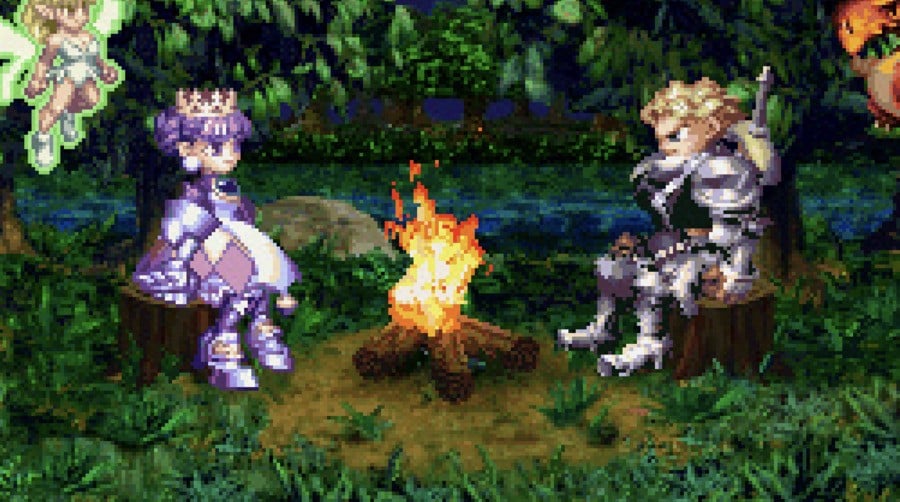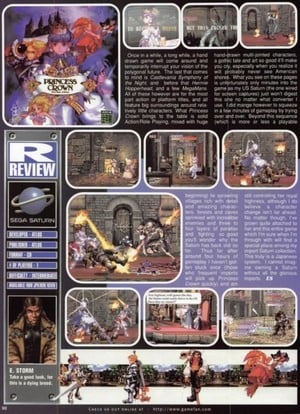
I'll never forget the first time I laid eyes on the Sega Saturn title Princess Crown. It was in a copy of the legendary GameFan magazine, with the equally legendary Dave Halverson singing its praises and lamenting the fact that the game wasn't being picked up for localisation in North America.
The gorgeous 2D visuals had an instant impact on me, and I immediately tracked down a second-hand copy at my local CeX store. It's still one of my favourite video game experiences of all time, despite the fact that I couldn't understand a single piece of text.

From the title, it might sound like the kind of game you’d expect your little sister to play, but it’s actually the first release from the team that would eventually become known as Vanillaware – the studio established by designer George Kamitani and a bunch of other former Atlus employees. Vanillaware would gain worldwide recognition for Odin Sphere and Muramasa: The Demon Blade, but Princess Crown is arguably where it all began – and showcases all of the company's best qualities.
As for Kamitani's pedigree, he previously worked for companies such as Capcom, creating pixel artwork for titles such as Dungeons & Dragons: Tower of Doom, Dungeons & Dragons: Shadow Over Mystara and Muscle Bomber / Saturday Night Slam Masters. Princess Crown began life at a company Kamitani had joined after leaving Capcom, which then went bankrupt. Sega stepped in, along with Atlus, to handle development and publishing.
Princess Crown's commercial performance wasn't great, and it led to Atlus' Kansai studio being shuttered and the reputation of both Kamitani and his team being diminished. Thankfully, Kamitani eventually established his own studio in 2002 – known initially as Puraguru and later, as Vanillaware – which went from strength to strength in the subsequent years; its latest effort, Unicorn Overlord, recently launched on modern systems to critical acclaim.
Originally released on the Japanese Saturn in 1997, Princess Crown is best described as an action RPG but with a strong emphasis on action. You control the young Princess Gradriel, who must venture out from the comfort of her childhood castle to save her beloved kingdom from certain doom.
The action is viewed from a side-on perspective, and the game world is comprised of towns, cities and dungeons joined by linear pathways. These roads must be traversed in real-time, and it’s here you’ll (randomly) encounter the vast majority of Princess Crown’s enemies.
When a combat situation occurs, the game switches to a (very basic) Street Fighter-style arrangement. You can move and attack just as you would in a one-on-one fighter, and it’s even possible to perform evasive moves and special attacks (albeit with much simpler button commands than in Capcom's game).
Enemies drop items which range from restorative food to offensive projectiles and spell-casting gems, and it’s even possible to ‘grow’ and cook special items – a mechanic which would be drastically expanded in its spiritual sequel, Odin Sphere. Furthermore, success in combat earns you experience points, allowing you to boost Gradriel's attack power and health.
It would be remiss of me to discuss Princess Crown without mentioning the obvious beauty of its hand-drawn graphics. Released at a time when Saturn was paying dearly in the West for its support of 2D over 3D, the game has ironically aged much better than its 3D contemporaries.
Everything looks positively gorgeous, from the detailed backgrounds to the wonderfully animated characters. The music – provided by Metal Slug composer Toshikazu Tanaka – is perfectly suited to the fantasy theme.
Playing through the game as Gradriel takes many hours, and once you’ve finished her story, additional characters are unlocked. These quests are shorter than the main one, but the way in which they intertwine with Gradriel’s tale is wonderful.
Sadly, the lack of an English version meant I was forced to rely on a fan-made translation FAQ to understand exactly what was actually going on back in the late '90s, but thankfully, the game's use of colour-coded text for key moments means it's relatively easy to see when you’ve triggered a story event, even if you can’t read Japanese. When you hit these triggers, you'll usually see a new pathway open up on the map screen, making it fairly obvious where to go next. While you’ll be missing out on a lot, it’s just about possible to play the game to completion without reading or understanding a single word.
The game's legendary status – twinned with Vanillaware's growing reputation over the decades – has engendered hopes of an English language version. Some assumed that when the game was ported to the Sony PlayStation Portable in 2004 it would finally get an international release, but sadly, that edition shared the same fate as the Saturn one and never made it out of its native Japan.
More recently, there's been a lot of drama surrounding an unofficial English translation for the game. After one notable attempt by former IGN scribe Anoop Gantayat to make the game playable to non-Japanese gamers many years ago, RomHacking member SamIAm solicited assistance in 2012 to translate the game. He was soon joined by Cyber Warrior X, and it seemed like good progress was being made.
However, despite intermittent updates, the translation remains incomplete – and it was only when a "new" project appeared from an individual named eadmaster that it returned to life.
Based on the older version of CyberWarriorX and SamIAm's translation (which was released under GPL, which gives developers the freedom to fork, modify and share back changes without asking for permission from the original authors), it was released to an understandable amount of fanfare, only for CyberWarriorX and SamIAm to publically state that the translation is "obsolete" and "embarrassing". They've both said that they will continue to work on their original translation, which will be "the one worth playing," while eadmaster has teamed up with MiYakuGaming to hone and improve his forked version.
So, is all the fuss over this decades-old game warranted? In my opinion, absolutely; it's one of the crown jewels of the Saturn library and I cannot wait to play it in English so I can fully enjoy the experience. Let's hope that now we've got two competing translation efforts we'll actually get to that point a little faster.
Thanks to Hardcore Gaming 101 for providing the screenshots used in this feature.





